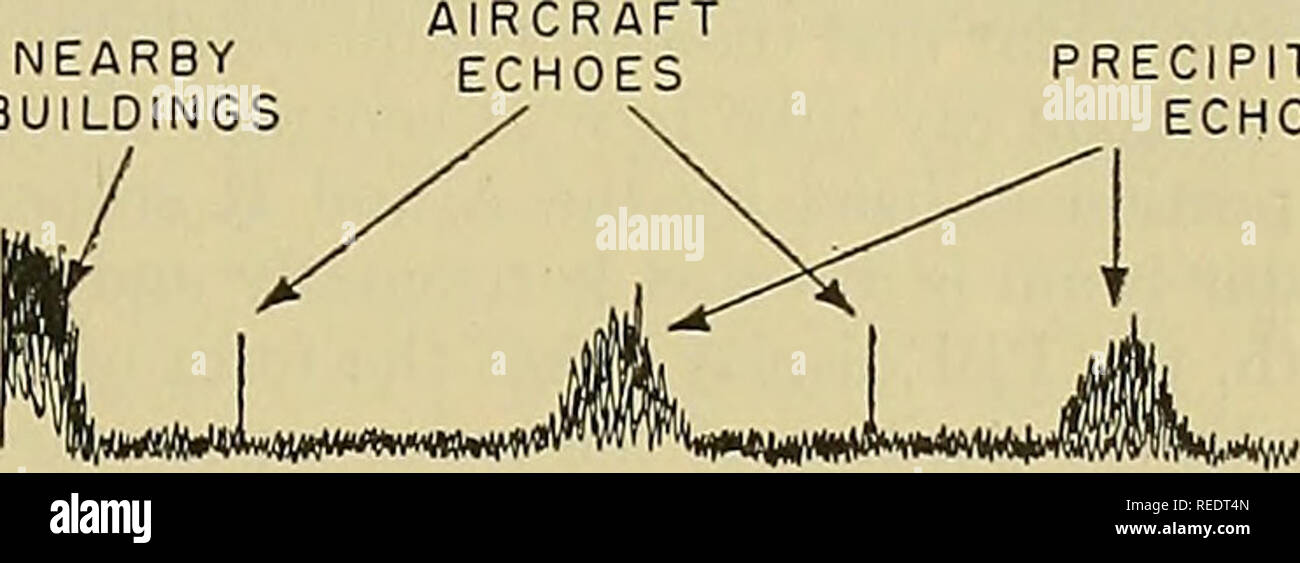. Compendium of meteorology. Meteorology. RADAR STORM OBSERVATION 1269 these distances are considerable even with respect to the heights of thunderstorms. In the determination of rainfall intensity by radar, it must be assumed that the reflectivity per unit vol- Table I. Beam Width Between Half-Power Points (in ft) Range (miles) Angular Width of Beam 0,7° 2° 4° 5 25 50 100 320 1,610 3,230 6,450 920 4,600 9,210 18,400 1,840 9,210 18,400 36,900 ume is constant in the volume of space contained by the limits of the beam and the pulse length. Because of the beam width of existing radar equipment, t

Image details
Contributor:
The Book Worm / Alamy Stock PhotoImage ID:
REDT4NFile size:
7.2 MB (206 KB Compressed download)Releases:
Model - no | Property - noDo I need a release?Dimensions:
2621 x 954 px | 22.2 x 8.1 cm | 8.7 x 3.2 inches | 300dpiMore information:
This image is a public domain image, which means either that copyright has expired in the image or the copyright holder has waived their copyright. Alamy charges you a fee for access to the high resolution copy of the image.
This image could have imperfections as it’s either historical or reportage.
. Compendium of meteorology. Meteorology. RADAR STORM OBSERVATION 1269 these distances are considerable even with respect to the heights of thunderstorms. In the determination of rainfall intensity by radar, it must be assumed that the reflectivity per unit vol- Table I. Beam Width Between Half-Power Points (in ft) Range (miles) Angular Width of Beam 0, 7° 2° 4° 5 25 50 100 320 1, 610 3, 230 6, 450 920 4, 600 9, 210 18, 400 1, 840 9, 210 18, 400 36, 900 ume is constant in the volume of space contained by the limits of the beam and the pulse length. Because of the beam width of existing radar equipment, this con- dition can rarely be fulfilled except very close to the radar where the linear distance across the beam is small. Even then, reasonably uniform rainfall condi- tions must exist. Distance of the Storm, R. This term is included in the equation to provide for range attenuation. If the storm completely fills the beam, range attenuation increases with the square of the distance. If the target consists of a point, such as an airplane, range attenuation in- creases with the fourth power of the range. Most in- vestigators, in making rainfall intensity measurements by radar, endeavor to make their observations as close as possible to the radar for two basic reasons: (1) to in- sure complete beam filhng by relatively uniform rain or snow, and (2) to reduce range attenuation, thus in- creasing the signal strength of the received echo [6]. OBSERVATIONAL VERIFICATION OF RADAR STORM-DETECTION THEORY Exact verification of the theory (or of equation (1)) is very difficult because of several factors. The value of Pr must be measured by averaging the power of very weak signals (about 10~^ to 10"^^ w) which are fluctuat- ing rapidly. Moreover, the precipitation echo signal is not received continuously from a given point in the storm but at intervals equal to the transmitted pulse repetition frequency. Techniques have been developed to measure Pr, however, and they will be discuss